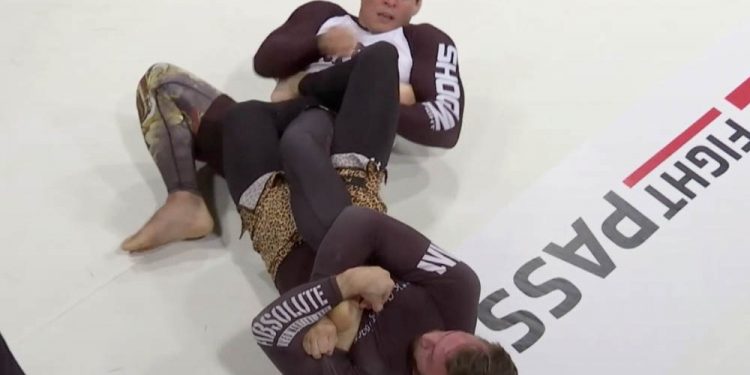How much time to tap do you actually need to give an opponent in competition? It’s a question that many newer BJJ practitioners might have asked themselves, and it’s something that many people already have a strong opinion on. Then when something happens in competition that some people deem too fast or too explosive, the internet explodes in fury. You can see this most recently with Pat Shahgholi’s heelhook finish of David Vieira at EBI 20: The absolutes. The same thing happened when Gianni Grippo submitted Ellis Karadag with a heelhook at Emerald City Invitiational 2, it has happened a dozen times before, and it almost certainly will happen again.
A quick search will bring up thousands of grapplers from all different stages of their journey freely giving their opinion in all sorts of different social media sites and forums, but out of the overwhelming sea of opinions that you can find from all corners of the internet, which ones do you listen to? Surely the best people to ask on the topic would be the men and women actually out there putting their bodies on the line at the highest levels of the sport, right? That’s what we thought, and that’s exactly how we decided to answer this question.
Our first port of call was David Vieira, the athlete who was actually on the receiving end of the heelhook by Pat Shahgholi at EBI 20, and he had this to say on the incident:
“I can not complain, this is part of the game. This kind of situation happens.”
We didn’t just stop there though, we wanted to get the opinions of as many high level competitors as possible. We mentioned both the Pat Shahgholi v David Vieira match and the Gianni Grippo v Ellis Karadag match as reference-points for them, as both generated a lot of controversy online. We then asked them to give their opinions on giving an opponent time to tap as a general idea, as it relates to either/or hobbyist and professional competition. These are the responses we managed to gather:
Elisabeth Clay (IBJJF no gi world champion and four-time IBJJF no gi pans champion)
“Honestly in my opinion if you sign up for a competition you know that. As long as it’s nothing illegal you’re doing but it’s just going hard on a submission in competition, especially at the professional level, that’s just a part of it. As a colored belt I lost matches by being too nice with a submission and you learn in competition you can’t do that. Again though, competition and training are two very different things. I’ve had to break people’s feet before because they won’t tap till that point and sometimes even then they won’t, and you have to move onto something else. It’s a competition and I do think that’s more so at the professional level, but that’s what I can speak on.”
Hunter Colvin (Combat Jiu-Jitsu veteran and ADCC trials finalist)
“At the elite level, it’s a combat sport and it’s your job to win not take care of your opponent. At the hobbyist level I think it’s smart not to allow heelhooks until brown or black just to keep people on the mats uninjured and in the sport”
Alan Sanchez (EBI Welterweight champion and IBJJF brown belt no gi world champion)
“It’s professional grappling and I think it’s fair for Pat to do what he did. In MMA sometimes you see brutal knockouts, in pro grappling sometimes you see brutal submissions. It’s important to understand when to tap early if you’re worried about getting hurt. There’s also people out there who are very comfortable with their escapes and at a high level they will escape if not applied with intention. Hate to see people get hurt but these submissions have risks. Chokes put people to sleep and joint locks break people’s limb. It’s the game we’re playing. If this was a local tournament or a training session its different but both those examples are pro tournaments with 5 figure pay.”
Andre Galvao (Longest reigning ADCC Superfight champion and ADCC Hall of Famer)
“Competition is one thing, training is another thing.”
Vagner Rocha (Three-time ADCC world championships medalist)
“Giving someone time to tap is something you definitely do in the gym with your training partners. In competition there isn’t an expectation to give the person time to tap. Then again I think anything that is done fast and spazzing is usually not good in Jiu-Jitsu. Best way to tap is verbal to learn your limits and your threshold.”
Devhonte Johnson (IBJJF no gi world champion and IBJJF no gi pans champion)
“I’m familiar with both and I’m also ok with both, it’s hard to tell a Jiu-Jitsu athlete trying to make a life for themselves through Jiu-Jitsu to give an opponent time to tap. In a high level match where the skill levels are close, when you get an opportunity to do anything you test it with the upmost urgency because you know the opportunity may never come again. And so the chances of you winning and losing are dependent on your ability to execute. I’ve seen many cases also where guys tap but they do so in a shady way, the opponent lets go, and they go “oh i didn’t tap.” I’ve had this happen to me before with an armbar. I tried to give the guy time to tap and he lied about tapping, so the next time I got the arm I made sure I got the arm haha and it popped a lot, sounded like wood breaking but that’s the price you pay in competition. It’s really difficult to limit the risk for injury, I think all athletes try to but at the same time we’re also trying to win.”
Ashley Williams (ADCC Trials winner and Polaris triple-weight champion)
“In a professional setting it is totally acceptable for a submission to be attacked as hard as possible! The only thing I would add is I believe you must have control and the ability to release when there is a tap. There is nothing in the rules stating you can’t rip a submission but there is a rule where you must release when an opponent taps. If I were in a competition and tapped for my opponent to not release I would be pissed.”
Robert ‘Degle’ Diggle (Polaris, F2W, and ADCC Trials veteran)
“In a sport that allows joint locks I don’t see how you could effectively police people actually trying to perform joint locks as fast and as efficiently as possible without more or less changing the sport itself on a fundamental level. To that end the idea that any competitor at an elite level isn’t going to try and break his opponent is absolutely ludicrous. No one is ever going to give me time to escape so that means I have to either be ready to tap or to defend immediately (depending on how late it gets). The consequences of that choice are on me and vice versa are on my opponent when I’m the one attacking. That’s the nature of the beast and if you’re unhappy about people doing Jiu-Jitsu in Jiu-Jitsu tournaments, don’t participate in them. I’m much more troubled by adult men on social media fat shaming/borderline cyber bullying a teenager than I am by someone doing Jiu-Jitsu in a Jiu-Jitsu tournament.”
Tom DeBlass (ADCC veteran and former UFC fighter)
“I think this is a tricky situation because as a competitor your main goal is to win. Especially when you’re competing at the highest levels for prize money, right? However you never want to hurt anyone, so the dilemma becomes: Should he go lighter and give people a chance to tap and possibly lose a submission or should he crank it and hurt his opponent? I think ultimately as competitors we have to understand, that’s something that you have to decide personally; what you wanna do for yourself. However, everyone going into the competition must prepare for the latter. Everybody must prepare for the person to be willing to break them in order to win. So you see, he didn’t win the entire competition so there were people in there that were effectively able to defend his cranks.”
“Ultimately I believe most high-level competitors, if you ask them at the highest levels: “are they willing to risk injuring their opponent for victory?” I think they’re gonna say yes. I mean, in Jiu-Jitsu in general we apply submission holds, breaks, chokes, and cranks that if our opponent doesn’t tap in time they’re going to get hurt. Personally, I’ve never ripped any submissions before. That’s me personally. However, I have had people try to rip submissions on me in competition and it never offended me on a personal level because I understood that the name of the game is winning. I think it’s similar to MMA, I’ve knocked opponents out before and after I’ve knocked them out I’ve felt horrific and terrible after I did it, but I knew I had to do it.”
Eoghan O’Flanagan (Top four finisher at ADCC and Grapplefest 90kg Champion)
“To be honest I would like to have time to tap, but I don’t really have time to give anyone time to tap either. People are dumb as f*ck so gotta actually go to break it whether or not they’re gonna do any stupid risks unfortunately. That means the good guys get f*cked just as bad as the guys who fight tooth and nail to get out of bang to rights submissions.”
Mason Fowler (SUG Openweight champion and two-time ADCC trials winner)
“Should we crank submissions in competition? The short answer is, maybe. If you are at the “adult black belt” level of competition, it is common that you see competitors actually letting their limbs break in order to not lose. That’s because there is so much on the line for those athletes. They treat this as their profession and have more incentive to not lose. Pat Shahgholi for example, was competing for a shot at 50k. Some would call that life changing money for a young 16-year-old. In this form of competition, where competitors are letting their limbs break in order to fight out, you unfortunately must be ready to break said limbs if you truly want to win.”
“With that being said, if you apply the submission slowly at this level of competition you may be giving your opponent the time they need to escape. There is a big difference between athletes competing at this level and athletes competing at every other level. Do I think white belts should be breaking each other’s arms in competition? No. At an early level we should be teaching how to finish submissions with control in order to provide the safest training and competition experience. I also believe that even at the white belt level, if you are competing, you need to understand that if you do not tap in a reasonable time then you can expect yourself to be injured.”
“In my opinion, Pat did nothing wrong here and shouldn’t be taking heat for this. All of us know what we are getting into when we sign up for a 50k grappling tournament. But let’s make sure our beginners know the difference between how to apply submissions training at the academy and how to apply submissions while competing at the highest levels of the sport.”
Adam Wardzinski (ADCC trials winner and IBJJF European champion)
“In my opinion Jiu-Jitsu is about tapping your opponent out and that means sometimes we need to go for a sub fast cause applying it slow may give time to our adversary to escape. Doesn’t matter if it’s a flying armbar, sharp kimura or heelhook – the risk is there. Going into the fight you must consider that you may get injured at one point and by signing up you accept the risk. Of course any sane competitor doesn’t want to injure his opponent but still they do what they have to to win. We can’t forget that our responsibility is also to always protect ourself during the match including not putting ourself in dangerous spots. Also, Jiu-Jitsu is relatively safe sport compared to other contact fight sports, even though injuries may happen, sometimes even nasty ones, so I think everyone has to make a calculation – If professional, is the money prize or title on the line worth risking health. If amateur, is the rule set safe enough for one to go there, have fun and be able to get back to job on Monday.”
Tommy Langaker (ADCC trials winner and IBJJF European champion)
“I would say it’s fair game, it’s nothing I would preach to other people, but you should be able to do it under control and not harm your opponent. But in a match we are there to win and this is combat sports, so it is fair game although it sucks having to be injured or injuring others.”
John Hansen (ADCC Veteran and Grapplefest openweight champion)
“Grappling is a combat sport; it’s a fight. I think the theatre of combat can have something to do with it. I.E: If you’re breaking people at the local NAGA, up your game bro. However, if you’re in a shootout with Craig Jones at the ADCC, have your tap hand out and be ready to use it liberally. Outside of that, I don’t think it makes you a “good guy” to give someone the chance to escape. I do, however, think it shows the level of skill you have when you’re a guy like Gordon and you know you’ve got them dead to rights, and can apply slowly and safely to get the submission. That doesn’t mean you are any more or less skilled if you’re Craig Jones, that hips into subs scary fast. It’s a fight. The competitor accepts that risk when he steps on the mat. Likewise, if you can gain the victory without damaging someone that’s probably best, or we’re going to quickly be entering a world of a knee for a knee leaves the whole word broken”
“To summarize: if you’re competing at the elite/pro level, a competitor steps on the mat giving no quarter, and expecting none. Submissions are part of the game, and submissions from leg entanglements are part of that meta. To expect a fighter to give an opponent time to tap is ridiculous. Is it a nice gesture that he does that? Absolutely. Does it yield any insight into their personality, ethics, or morality? No. They just want to win. By the time someone is at that level, they aren’t there to find themselves; try out a new hobby; and make a friend. They’re there to win. Winning within the rules is paramount. If that’s too difficult to comprehend for some, it’s because those people have never been at that tier in any hierarchy in their life.”
The consensus on giving time to tap
So, there you have it. We gathered as many responses as we could from athletes who have competed and won at the very highest levels of the sport. What you can gather from that is a general consensus that appears across the board. Nobody wants to injure an opponent, but pretty much everyone acknowledges that they have to be willing to do so in order to win. The training room is different, where the goal is to learn and not to win. Everybody is doing everything they can to avoid injuring their training partners but the fact is that some people in competition are willing to let their body break, or simply hoping that it doesn’t, in order for them to escape. The only way to effectively fight against that is to be willing to apply the break yourself, and as quickly as possible.
The views on how much time they personally give an opponent to tap differs slightly between athletes, but not a single one of the competitors we spoke to said they expect their opponent to give them any time at all. They all step onto the mats at every single competition knowing full well that the person opposite is going to try their best to break something if they catch them in a submission, and they use that information to decide when they want to tap. They all take their safety into their own hands, and none of them seemed to put any blame on an opponent for injuring them provided they release when the tap is done.
We reached out to several other competitors who have not yet given a statement at the time of writing, but this article will be updated as and when any further athletes respond.













